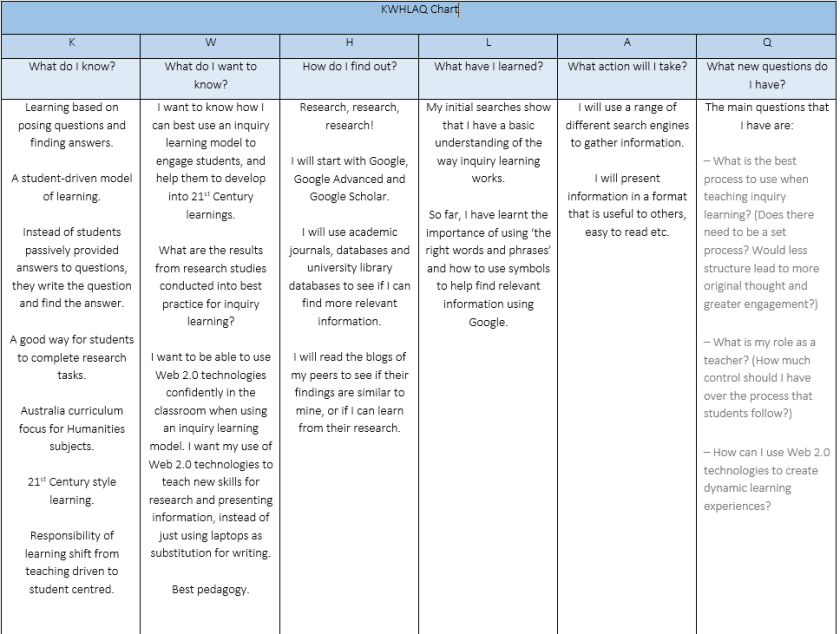Posing questions? Finding multiple answers? Student-driven research?
As a Junior Secondary Humanities teacher, my understanding of inquiry learning is predominantly based on historical inquiry processes. The Australian Curriculum: History required that students learn to ‘developing knowledge and understanding…by asking questions about the past, and applying skills associated with analysing, interpreting and evaluating sources of evidence to develop informed and defensible answers’. (ACARA, 2009, p.7). When I facilitate research tasks, my class follows a model that seeks to develop understanding and interest by formulating inquiry questions and learning how to use and interpret historical sources. The Australian Curriculum: History also stipulates that student should learn to answer ‘inquiry questions through the use and interpretation of sources’, however, this links to specific key questions, whereas we write our own (ACARA, 2013).
Inquiry learning is not a new approach, and this model of teaching has been used in schools as an interactive and student-driven process. What is new, I believe, is the way that student navigate their study: a shift away from published books to using the internet and Web 2.0 technologies.
The Road Already Travelled

The process that I use is based on the model presented by Dr Cornelia Brunner, who separated inquiry learning into four main parts. This image is displayed on my classroom wall. I find that these questions help prompt students’ thinking. When teaching the process to Year 8 students, we break down the sections so that after conducting general feedback students can revisit their questions and change as appropriate.
1. Brainstorm (mind maps, KWHLAQ charts) to formulate inquiry questions
2. Conduct preliminary research/what information is available?
3. Compose research questions: ‘big questions’ and ‘sub-questions’
4. Answer the questions, using multiple historical sources
5. Use this information to produce final piece of work
For Year 8 students, our ‘big questions’ are usually ‘why’ or ‘how’ to try and allow for multiple answers and ideas. In this regard, I realise that I approach research tasks with quite a fix mindset, as this is how I have always taught the process, and I have not questioned whether there are better ways to guide students – or if I should be providing them with more freedom to explore!
The Road Less Travelled
I want to instil in my students a desire to engage with information by questioning and challenging the sources of information that they hear, read and see. Students have more access to information then I did in high school, however this brings new complications, and a lot of my teaching focuses on the reliability of information. Yet knowing what information to guide students to is something I often find challenging as I worry that I am too directive, and unintentionally stifle their creativity. Furthermore, I am not confident using Web 2.0 technologies in the classroom.
Planning the journey: KWHLAQ

I am eager to expand my understanding of best practice when it comes to the teaching of inquiry and critical thinking. I will focus on teaching Junior Secondary History, as this will be most beneficial to my everyday practice. The main questions I will endeavour to answer are:
– What is the best process to use when teaching inquiry learning? (Does there need to be a set process? Would less structure lead to more original thought and greater engagement?)
– What is my role as a teacher? (How much control should I have over the process that students follow?)
– How can I use Web 2.0 technologies to create dynamic learning experiences?
References
Australian Curriculum, Assessment and Reporting Authority [ACARA]. (2009). Shape of the Australian Curriculum: History. Retrieved from http://www.acara.edu.au/_resources/Australian_Curriculum_-_History.pdf
Australian Curriculum, Assessment and Reporting Authority [ACARA]. (2013). Foundation to year 10 curriculum: History. Canberra, ACT: Commonwealth of Australia.
Brunner, C. as cited by YouthLearn. (2010). Inquiry Learning. Retrieved from http://youthlearn.org/resources/inquiry-based-learning/